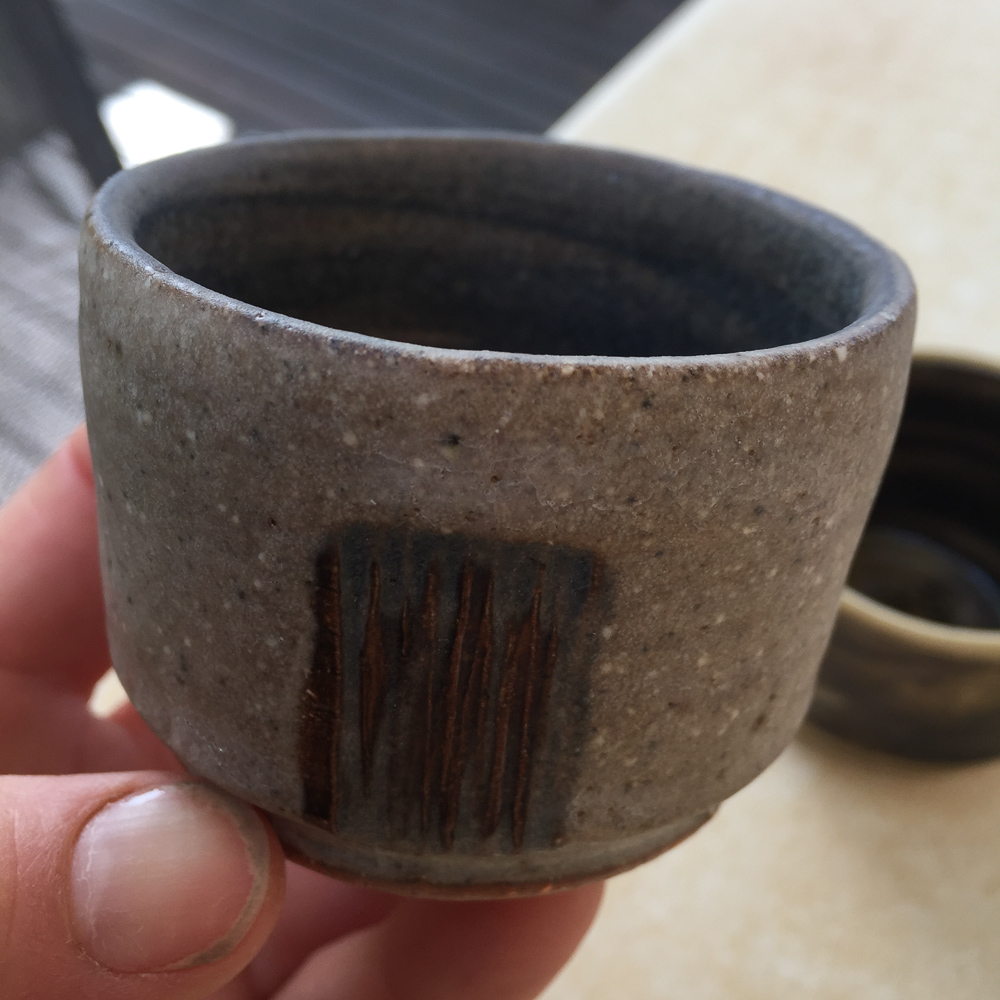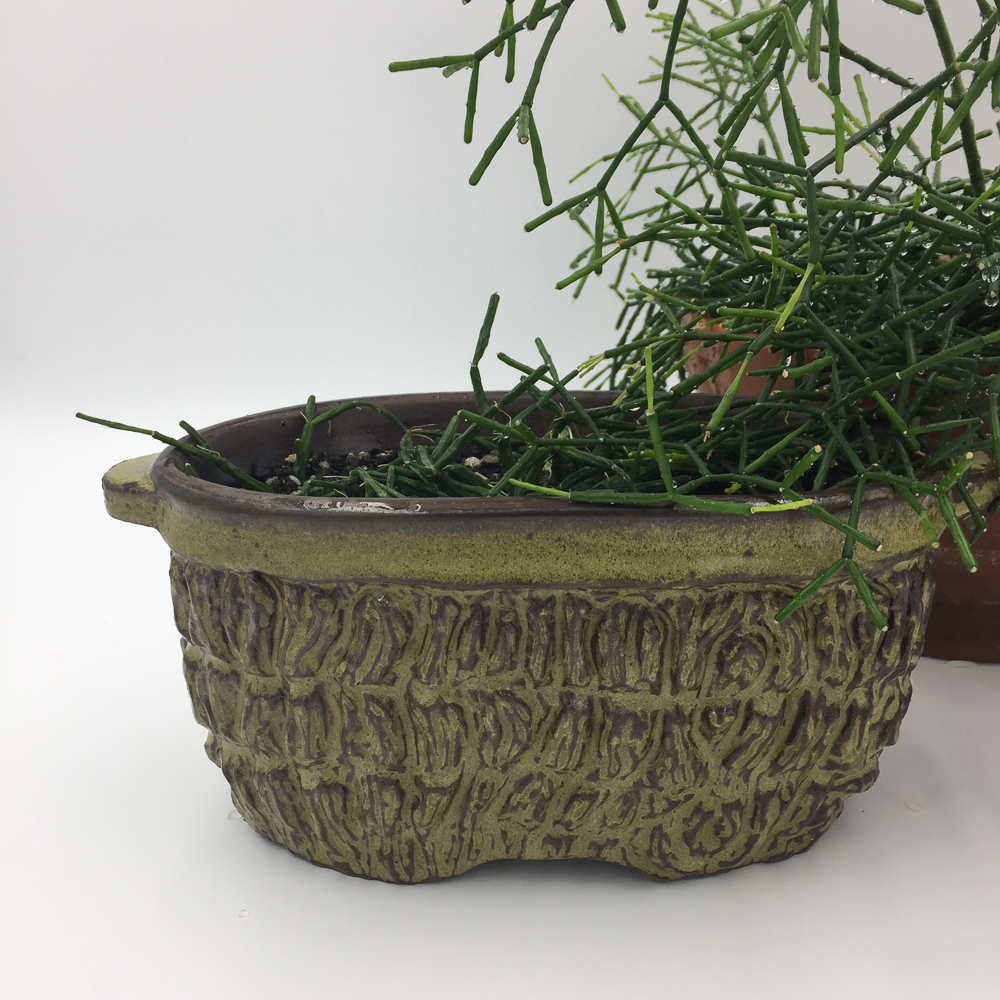- Hermie Cornelisse, Dynamic scale
- Hermie Cornelisse, Carved planter
Linda Fredheim interviews legendary Tasmanian potter Hermie Cornelisse about her return to making after a decade working in a shoe shop.
Tell me a little about how you started making.
The process of making pots gives me a direct route into active meditation.
It was not that I had gone out and sought pottery as my preferred profession. Teachers in art over my life have recognised something in my doing, they have asked me to join along, join in, and be part of the class and department.
It is as though pottery has chosen me. I believe the need to make pots came from the post-war dinner set, pots my parents brought over from the Netherlands in the early ’50s. The set was creamy white earthenware, with a single grassy sprig decal decoration fanned out over each piece. As a child, I held onto the memory of those pots, as each one broke over time, I yearned more for them to be whole and within a set. I still have some vision, or other, about loving those pots.
Despite your love of pots and achieving national recognition of your practice you stopped making about 12 years ago. What happened?
Twenty years selling work to galleries basically pulled the guts out of my energy supply. With no exception, galleries say they are open to ideas because it is their belief the new work will be based on what they have seen and know. In my experience gallery curators direct their preferences in style based on older work. Galleries could be good for artists, that is, the gallery curator owners could be more like the teachers and lecturers described earlier. – They could learn how to pluck out the talent and allow those artists to run with their visions.
There is a different model of exchange, one I have heard about recently. At a Ridgeline international workshop 2019, I met the potter artist Anne Mette Hjortshoj who says she deals exclusively with Goldmark Gallery, the deal being, she makes full time, is paid a weekly wage, and at regular intervals sends all her work to the English based gallery. The artist makes a regular income and the gallery can do what they know best – sell at the best market price.
I gave up pot making at the twenty-year mark around 2008; I had reached my goal of national recognition, with some money in the bank and more offers on the way: exhibition work and artist residencies. I gave up at the junction between having an established national market to having reached an international market. The Gulgong International Ceramic Workshop presented me with many opportunities: institutional representatives offered residencies and gallery space. I turned down every offer by making the decision to give up.
During the time of not making pots, ten years or so, I stopped everything; I stopped talking pots, thinking pots and collecting pots. I went so far as to purchase a commercially made dinner set, dishwasher safe and put many objects from my past in storage. I was offered work in the best shoe shop in Tasmania, a part-time wage made up for the pot making work of six days a week, 11 hours a day. I had more money and more time than ever. I designed and made a few jumpers for friends. I worked my veggie garden. I invited a few more friends for dinner. In a sense, I went numb and instead tried living a normal life.
But now you are back making and selling your work. What made you change your mind?
Starting again was not my idea. I had been to one exhibition opening in ten years and the second was a “closing opening” at Bett Gallery, an exhibition of pots by Les Blakebrough. There I bumped into all familiar faces including Ben Richardson. During the course of the closing ceremonies, Ben approached me and asked me if he offered me access to space and equipment would I be interested in starting up pot making again. After a week of thinking I went over to Ben and Peta’s place, Ridgeline, and checked if I had heard that offer correctly. From reassurances over a cup of coffee, with cream, I accepted the offer. I have borrowed a Brent wheel from Ben and work in my purpose made studio in North Hobart. I pack up my dried pots and take them to Ben’s to bisque, glaze and glaze fire. And I have fallen in love with wood firing.
This time around, now more or less back in business, I am going to make and sell work in an old fashioned way, my way, from my studio and from markets, so that I can be in contact with the individuals who hunt out good craft and offer a simple open honest exchange: pots for money.
I think of making and selling pots as a form of exchange. Ideally, I will make exactly what I want and people can choose to buy it. – I will continue to have the ability to make more pots if my audience supports me.
I have been very lucky.
I would not have started making pots without the support of others.
People over my lifetime who have supported my doings are:
- Gerald Makin: master potter and teacher, Ulverstone, Tasmania
- Les Blakebrough: master potter and lecturer, Hobart, UTAS, Tasmania
- Val Nicholls: potter and very long time friend
- Ben Richardson: master potter, teacher and mentor
- Peta Richardson: Ridgeline manager, ceramic technician, all round supporter
Hermie Cornelisse will exhibit a selection of new and some past pieces at the designed:made makers market, Hobart Town Hall, December 4th – 6th 2020
https://www.instagram.com/p/CHJbE3zBjgT/




Comments
Beautifully honest interview and what precious artwork you make / craft, on your profile – Thank you for sharing with this interview and congratulations on re-starting your practice your way. A nice shout-out to supporters who encouraged you